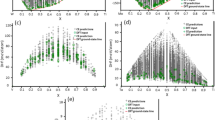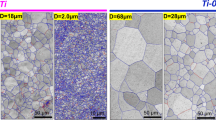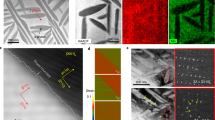Abstract
Impurities control phase stability and phase transformations in natural and man-made materials, from shape-memory alloys1 to steel2 to planetary cores3. Experiments and empirical databases are still central to tuning the impurity effects. What is missing is a broad theoretical underpinning. Consider, for example, the titanium martensitic transformations: diffusionless structural transformations proceeding near the speed of sound2. Pure titanium transforms from ductile α to brittle ω at 9 GPa, creating serious technological problems for β-stabilized titanium alloys. Impurities in the titanium alloys A-70 and Ti–6Al–4V (wt%) suppress the transformation up to at least 35 GPa, increasing their technological utility as lightweight materials in aerospace applications. These and other empirical discoveries in technological materials call for broad theoretical understanding. Impurities pose two theoretical challenges: the effect on the relative phase stability, and the energy barrier of the transformation. Ab initio methods4,5 calculate both changes due to impurities. We show that interstitial oxygen, nitrogen and carbon retard the transformation whereas substitutional aluminium and vanadium influence the transformation by changing the d-electron concentration6. The resulting microscopic picture explains the suppression of the transformation in commercial A-70 and Ti–6Al–4V alloys. In general, the effect of impurities on relative energies and energy barriers is central to understanding structural phase transformations.
This is a preview of subscription content, access via your institution
Access options
Subscribe to this journal
Receive 12 print issues and online access
$259.00 per year
only $21.58 per issue
Buy this article
- Purchase on Springer Link
- Instant access to full article PDF
Prices may be subject to local taxes which are calculated during checkout



Similar content being viewed by others
References
Otsuka, K. & Wayman, C. M. (eds) Shape Memory Materials (Cambridge Univ. Press, 1998).
Olson, G. B. & Owen, W. S. (eds) Martensite (ASM, Metals Park, Ohio, 1992).
Vočadlo, L. et al. Possible thermal and chemical stabilization of body-centred-cubic iron in the Earth's core. Nature 424, 536–539 (2003).
Kresse, G. & Hafner, J. Ab initio molecular dynamics for liquid metals. Phys. Rev. B 47, 558–561 (1993).
Jónsson, H., Mills, G. & Jacobsen, K. W. In Classical and Quantum Dynamics in Condensed Phase Simulations (eds Berne, B. J., Ciccotti, G. & Coker, D. F.) 385–404 (World Scientific, Singapore, 1998).
Vohra, Y. K. Electronic basis for omega phase stability in group IV transition metals and alloys. Acta Metall. 27, 1671–1674 (1979).
Jayaraman, A., Klement, J. W. & Kennedy, G. C. Solid-solid transitions in titanium and zirconium at high pressures. Phys. Rev. 131, 644–649 (1963).
Zilbershtein, V. A. et al. Alpha-omega transition in titanium and zirconium during shear deformation under pressure. Fiz. Met. Metalloved. 39, 445–447 (1975).
Vohra, Y. K., Sikka, S. K., Vaidya, S. N. & Chidambaram, R. Impurity effects and reaction kinetics of the pressure-induced alpha to omega transformation in Ti. J. Phys. Chem. Solids 38, 1293–1296 (1977).
Gray, G. T., Morris, C. E. & Lawson, A. C. In Titanium '92: Science and Technology (eds Froes, F. H. & Caplan, I. L.) 225–232 (TMS, Warrendale, 1993).
Sikka, S. K., Vohra, Y. K. & Chidambaram, R. Omega phase in materials. Prog. Mater. Sci. 27, 245–310 (1982).
Greeff, C. W., Trinkle, D. R. & Albers, R. C. Shock-induced α–ω transition in titanium. J. Appl. Phys. 90, 2221–2226 (2001).
Trinkle, D. R. et al. New mechanism for the α to ω martensitic transformation in pure titanium. Phys. Rev. Lett. 91, 025701 (2003).
Trinkle, D. R. A Theoretical Study of the Hcp to Omega Martensitic Phase Transition in Titanium Thesis, Ohio State Univ. (2003).
Conrad, H. Effect of interstitial solutes on the strength and ductility of titanium. Prog. Mater. Sci. 26, 123–404 (1981).
Hahn, T. (ed.) International Tables for Crystallography Vol. A. (Kluwer, Dordrecht, 1996).
Kutepov, A. L. & Kutepova, S. G. Crystal structures of Ti under high pressure: theory. Phys. Rev. B 67, 132102 (2003).
Rudin, S. P., Jones, M. D. & Albers, R. C. Thermal stabilization of the hcp phase in titanium. Phys. Rev. B 69, 094117 (2004).
Estrin, E. I. Concerning polymorphous (normal, martensitic) transformations. Fiz. Met. Metalloved. 37, 1249–1255 (1974).
Kresse, G. & Furthmüller, J. Efficient iterative schemes for ab initio total-energy calculations using a plane-wave basis set. Phys. Rev. B 54, 11169–11186 (1996).
Vanderbilt, D. Soft self-consistent pseudopotentials in a generalized eigenvalue formalism. Phys. Rev. B 41, 7892–7895 (1990).
Kresse, G. & Hafner, J. Norm-conserving and ultrasoft pseudopotentials for first-row and transition elements. J. Phys. Condens. Matter 6, 8245–8257 (1994).
Perdew, J. P. in Electronic Structure of Solids '91. (eds Ziesche, P. & Eschrig, H.) 11–20 (Akademie, Berlin, 1991).
Acknowledgements
This research is supported by DOE Grants No. DE-FG02-99ER45795 (OSU) and No. W-7405-ENG-36 (LANL). Computational resources were provided by the Ohio Supercomputing Center, NERSC, and QSC at LANL. We thank G. T. Gray and M. Asta for helpful discussions.
Author information
Authors and Affiliations
Corresponding author
Ethics declarations
Competing interests
The authors declare no competing financial interests.
Rights and permissions
About this article
Cite this article
Hennig, R., Trinkle, D., Bouchet, J. et al. Impurities block the α to ω martensitic transformation in titanium. Nature Mater 4, 129–133 (2005). https://doi.org/10.1038/nmat1292
Received:
Accepted:
Published:
Issue Date:
DOI: https://doi.org/10.1038/nmat1292
This article is cited by
-
Grain growth and precipitation behaviour of AISI 430 ferritic stainless steel subjected to pulsed laser beam welding using free-form pulse shaping
Welding in the World (2023)
-
A Review on Additive Manufacturing of Titanium Alloys for Aerospace Applications: Directed Energy Deposition and Beyond Ti-6Al-4V
JOM (2021)
-
Role of Microstructure on the Shock-Induced Strengthening Behavior of Ti–6Al–4V Alloy
Metals and Materials International (2021)
-
Phase Transformation Graph and Transformation Pathway Engineering for Shape Memory Alloys
Shape Memory and Superelasticity (2020)
-
Insight into point defects and impurities in titanium from first principles
npj Computational Materials (2018)



